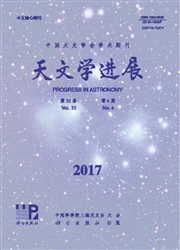

 中文摘要:
中文摘要:
恒星形成星系的恒星形成率与其恒星质量的相关关系被称为恒星形成星系主序关系,是描述星系演化的基本关系之一。准确测定不同红移处主序关系的斜率、弥散和零点能够对理解星系恒星形成活动的演化及其物理过程提供关键的观测限制。已有的研究揭示,恒星形成星系的整体恒星形成率从z-2到z-0下降为原值的1/30,气体消耗时标却由5亿年增至15亿年;主序关系的斜率在大质量和小质量星系段有变化,反映出决定恒星形成活动的物理过程有系统差别;而星系可能经历多个阵发性的恒星形成爆发活动,有助于更好地解释主序关系的弥散。随着观测能力的提升,对高红移宇宙(z-1-3)的恒星形成星系的研究也更加深入。恒星形成星系主序关系的特征随红移的变化规律为理解星系演化提供关键的观测约束。
 英文摘要:
英文摘要:
The tight correlation between star formation rates (SFRs) and stellar mass among star-forming galaxies (SFGs) is often referred to as the main sequence of SFGs, which is one of the fundamental relations involved in galaxy evolution. Characterizing the slope, normalization and scatter of the main sequence provides key constraints on our un- derstanding of the physical processes regulating star formation in galaxies. The global SFR drops by about a factor of 30 from z-2 to z-0, while the timescale of gas consumption increases from 0.5 × 10^9 to 1.5 × 10^9 years. The slope of the main sequence changes from the low-mass end to the high-mass end, indicating that the physical processes governing star formation are of dependence on galaxy stellar mass. The scenario of staged galaxy formation offers reasonable explanations for the scatter in specific SFR (SSFR). Starburst galaxies lying off the main sequence with high SSFR contribute merely part of the cosmic star formation density, but probably play an important role in quenching star formation. Investigations of the main sequence of high-z SFGs requires much efforts with next generation observing facilities. The studies of the main sequence of formation and evolution. SFGs thus provide key insights into galaxy
 同期刊论文项目
同期刊论文项目
 同项目期刊论文
同项目期刊论文
 期刊信息
期刊信息
